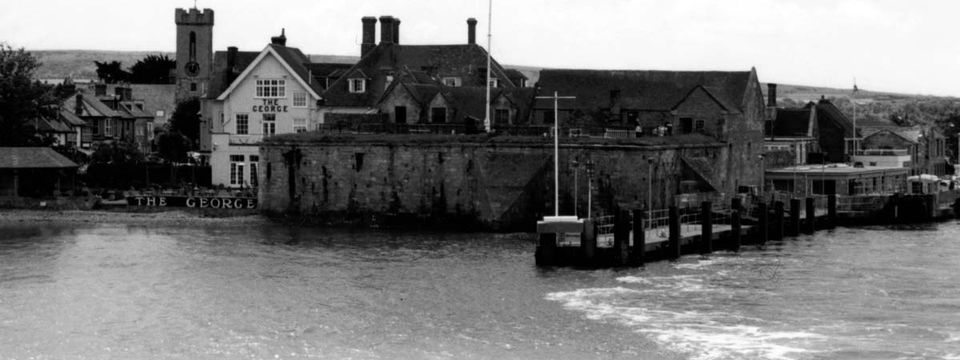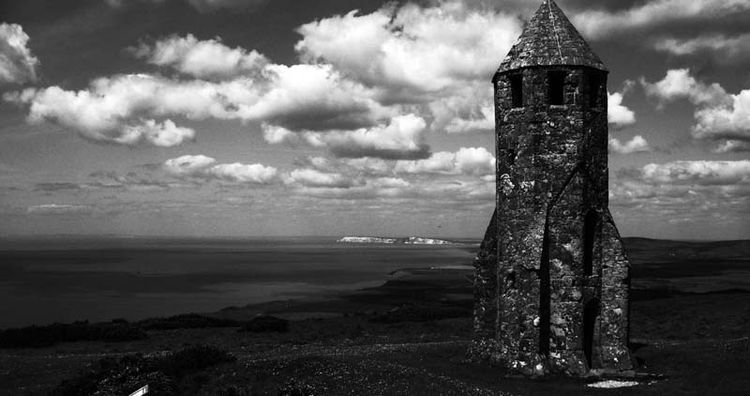Yarmouth. Ghosts of the Isle of Wight, with Margo Williams.

Yarmouth Church Tower
DURING THE EARLY 1800s Yarmouth church received a new tower which did not please a number of prominent personages at that time.
‘Too plain! Too solid! Too tall!’ complained some.
But what did they expect from a man obsessed with solid structure? A man who quite literally came back to haunt them.
Some Yarmouth folk have wondered if the ghost sometimes seen roaming the castle and streets around the church is Admiral Sir Robert Holmes. Appointed Governor of the Isle of Wight in 1667 Holmes was responsible for structural town defence improvements.
Others say it is doubtful that his lordship would settle for a quiet ghostly retirement in Yarmouth, as his taste for adventure would likely draw him to a death with more ‘life’, so to speak, haunting a battleship.

Others wonder if the ghost is Alfred Lord Tennyson, who travelled often from Yarmouth when coming and going from London engagements and his home in Freshwater.
However, Freshwater paranormalists claim he is too busy haunting the hills above Freshwater Bay and doesn’t come down looking for the old ferry boat like he used to; even though his body remains buried in Westminster Abbey.
Most local Yarmouth residents believe his famous poem ‘Crossing the Bar’ was inspired by the town’s ferry.
A Ghost of Yarmouth
However, the ghost of Yarmouth’s church and castle was not Sir Robert, or the old Poet Laureate, but he was one of the town’s famous former residents.
I saw and heard him first inside the castle and he provided enough information for Walter to identify and confirm him as architect and eccentric Yarmouth celebrity Daniel Asher Alexander who lived in the town during the first half of the 19th century.
“...How diligently you persevere to find me,” he said, cheerily. “May I introduce myself, madam? Daniel is my name, well known in Yarmouth. The castle was a great joy to me, a link with a past age. I spent so much of my leisure time wandering round and seeing what might be done to restore it.
Many of the people around thought me quite mad, but when I passed over the barrier where castles and time do not matter, I realised they had thought much about me. Mayhap I can continue at a later stage. Come back and sit in the entrance. Farewell until then.”
I waited several minutes but he spoke no more; then again read his words and realised he wanted us to follow to the entrance. So we did.
“Alexander, Alexander, how wrong can a man be with the thoughts he carries around with him?” he continued. “The good people of Yarmouth appreciated my work, yet I had not the wit to realise this. What misery I stored up for myself.
Learn from my mistakes, lest you also suffer like I have. Yet without your help I could not go further. I am sure you already have this knowledge, so I waste precious time. If you would be so kind as to proceed to the church nearby, I feel I shall be helped, and maybe you too will be helped.”
The misty figure drifted through the castle gate and down the narrow alley into the street; then vanished. The church is not far away, so we followed through the town square to find him waiting by the church.

“Thoughts are more important than buildings,” he continued. “This I hope you all know, but I did not. The educated men know so little, yet they boast over their knowledge. You are very kind to take trouble over the man of the past. Your husband and your friend pray for me and wish me to go to a celestial city.
I promise I will only have good thoughts, as I perceive circles of light around each of you, which come to me. “Come, come,” they say. They will lead me to the celestial city where there will be towers, castles and buildings that exceed my dreams. My thanks, my most grateful thanks, as I join the circles and rise up.”
Identifyng the Dead. Daniel Alexander
Records confirm Daniel Alexander was born in 1768 in London, and died in 1846.
A civil engineer, he moved to the island in 1825 and his contribution to the town provoked mixed reactions. The tower was built in 1831, three years after the death of his second son, Henry.
Although a Baptist, Alexander was given the project of extending the church tower by nine metres. It was to serve as seamark memorial to his lost son.
Alexander had designed Dartmoor prison; Maidstone prison, and a number of lighthouses; and when the vicar asked for his expertise in improving the church, there was much anticipation.
Unfortunately some island clergy were displeased with the result. Reverend Venables opined on how Yarmouth church, ‘Has recently received an addition to its height, with but small increase to its beauty.’
Reverend Cox was more scathing: ‘The modern tower of 1831, raised considerably after an utterly unsuitable and repellent fashion.’
Perhaps Daniel Alexander listened more than he should to such sniping criticism, for others agree it is beautiful, in a solid plain kind of way. But what else would be expected from a man so fascinated by towers and castles?
Most ferry passengers toing and froing were glad of its large visible timepiece. Doubtless town mayors and members of parliament who succeeded Maurice Bocland set their watches to it before catching the ferry for the Lymington train up to Waterloo station in London.
To share their wise opinion and constituents’ complaints in the Houses of Lords and Commons in Westminster. Where the miracle of democracy arrived courtesy of a famous but now forgotten eccentric king of England; buried close by, in the world’s greatest celebrity graveyard.
Pure curiosity stirred me to catch a train to London; to investigate the fabled Gate of Heaven, Westminster Abbey, to determine if there truly is a fixed exit portal in the city.
And confirm whether high intensity of fame offers protection from becoming a ghost.
Thank you for your company on this short tour of Isle of Wight mysteries and haunting. If you would like to know more about Margo Williams' investigations and other famous and forgotten personages, read this book. Now available from Amazon.





